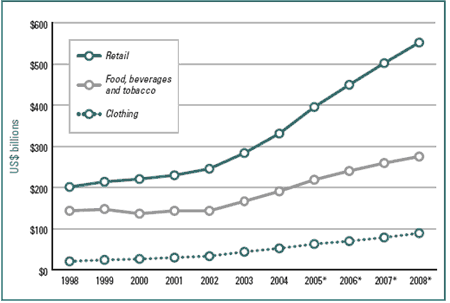Fast Food Chains in India
In India the retail sector is witnessing an overhaul throughout whether it is food, beverage or clothing etc. India is ranked amongst the top most emerging retail markets and is rated second in a Global Retail Development Index of 30 developing countries. Food and clothing are the key drivers of growth in the retail sector. Organized retail units are largely concentrated in urban areas, where on the other hand retail units in rural markets emerge as a huge opportunity reflected by the share of consumption by the rural market.
Graph showing growth Retail Sales trend in India from 1998*-2008*

One of the most flourishing sectors is the service industry/Hospitality sector. As a layman hospitality is the service given to people. The primary focus in the hospitality sector is on the service to be provided to the customers.
The different profiles in which an individual can be absorbed depending upon their skills and qualification in the hospitality sector are Management Trainee, Customer Relations Executive, Marketing/Sales Executive, Kitchen Management/ House Keeping Management, Catering Officer or Chefs in Hotels, Flight Kitchens, Cruises, Fast Food Chains and related industry.
Fast food is one of the world’s fastest growing food types. Fast food sector and restaurant industry is witnessing rapid growth all across. The revenue share generated from the restaurant industry in the developed countries is very high share and continues to expand.
In India snacks are one of the most preferred delicacies with various types of snacks being served and enjoyed by people all across the country. The consumer base has ascended tremendously witnessing changes in the eating habits of the consumer, especially in the urban areas.
The rising income level and changing consumer habits contributes radically to the fast food consumption trend. Due to which, all national and international food players like McDonalds, Pizza Hut, KFC and Dominos are investing heavily to capture a productive share of the highly lucrative market.
The increasing brand awareness has led to rising consumption trend of multi cuisines thereby continually instilling interest of international player in the Indian market. One of the favorite destinations these days for opening such food joints and restaurant bars are malls and supermarkets which are more organized modern formats. Big business houses in order to promote their brands are collaborating with small franchisors and mall owners.
The emerging fast food chain segment comprises of fast food joints, cafes and fine dining restaurants etc. The changing preferences of the Indian consumers have no doubt contributed to the success. Initially these brand outlets started only in major metropolitan cities such as Delhi and Mumbai. But today the food and beverage industry is continuously expanding all across India to cities like Pune, Ahmedabad, Aurangabad, Chandigarh, Jammu, Chennai, Goa and Bangalore, with a motive to capture growing demand.
A recent survey shows that in the previous year, around 400 fast food restaurants and snacks parlors have been set up in various cities and tourist destinations in the country under well known domestic and international food chain brands. In India most of the food chains cater to the urban and cosmopolitan population with high standard of living.
The most popular food chains that have their set base in India and cater to the vast consumer base are Pizza Hut, Domino’s, McDonald’s, and KFC etc. In the local brands, Café Coffee Day (CCD) has a significant share in the snacks market and in case of vegetarian fast food, Haldirams tops the chart. It is expected that in the coming years more fast food chains will open up and join the market with lots of money put in to expand the retail sales across different cities in the country. According to a survey there are more than 900 fast food restaurants and coffee shops in the country.
In India another area experiencing growth is the ‘Ready To Eat’ (RTE) market for food. RTE market basically consists of food products that make up a complete meal which needs minimal processing, if any, typically requires re-heating to desired temperature or addition of water. They are also referred as Convenience Food as they solve the problem of time-constrains faced by consumers due to the stressful life style.
RTEs are categorized into two products
- Shelf stable packaged food
- Frozen packaged food
The concept of RTE food has been recently accepted due to changing life style and movement towards westernization. There is a strong correlation between the growth of RTE foods and organized retail formats such as supermarkets and hypermarkets. These trends show that the modernization of India is well on its way. These changes in the eating habits are being referred to middle class and upper earning class of India.
Apply for Restaurant Manager Certification Now!!
https://www.vskills.in/certification/certified-restaurant-manager

